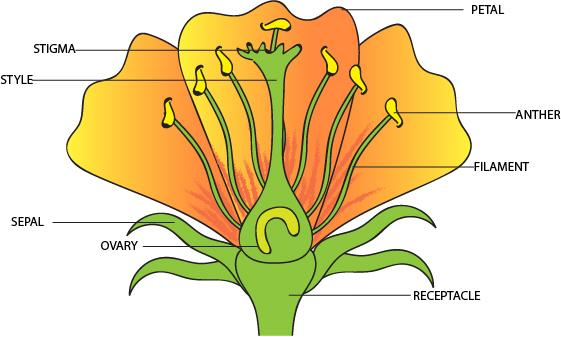
Draw the diagram of a flower to show it male and female reproductive parts. Label the following on it.
a) Ovary
b) Anther
c) Filament
d) Stigma
Answer
412.2k+ views
Hint: A flower has four major parts which are responsible for different activities in the flower. The reproductive parts are responsible for the development of fruits and seeds whereas the non-reproductive parts help in pollination and nutrition for the plant.
Complete solution:
Given below is the diagram of a flower with the male as well as the female reproductive parts labelled on it.

The part of flower that carries the travelling gamete (anther) is considered male reproductive part and the part that receives it is considered as the female reproductive part of the flower. At a time, flower can either be unisexual or bisexual. The flowers which are neither in the possession of male parts nor female parts are called neuter flowers and they cannot produce fruits at all. The flowers which have both, male and female parts are called Hermaphrodite flowers.
The ovaries and ovules are the two parts which are crucial for the flower after the fertilization has taken place. The ovaries develop to form the fruits and the ovules develop to form the seeds which further develop into new plants after germination. The petals and sepals of the flower are all rendered useless after fertilization and they fall off to direct the nutrition to the major parts of the flower.
Note:
In plants, the flowers hold sexuality as they carry the reproductive parts thus are the seat of fertilization. These reproductive parts have been divided into two categories, that is, the male (the motile gamete) and the female (non-motile gamete).
Complete solution:
Given below is the diagram of a flower with the male as well as the female reproductive parts labelled on it.

The part of flower that carries the travelling gamete (anther) is considered male reproductive part and the part that receives it is considered as the female reproductive part of the flower. At a time, flower can either be unisexual or bisexual. The flowers which are neither in the possession of male parts nor female parts are called neuter flowers and they cannot produce fruits at all. The flowers which have both, male and female parts are called Hermaphrodite flowers.
The ovaries and ovules are the two parts which are crucial for the flower after the fertilization has taken place. The ovaries develop to form the fruits and the ovules develop to form the seeds which further develop into new plants after germination. The petals and sepals of the flower are all rendered useless after fertilization and they fall off to direct the nutrition to the major parts of the flower.
Note:
In plants, the flowers hold sexuality as they carry the reproductive parts thus are the seat of fertilization. These reproductive parts have been divided into two categories, that is, the male (the motile gamete) and the female (non-motile gamete).
Recently Updated Pages
Can anyone list 10 advantages and disadvantages of friction

What are the Components of Financial System?

How do you arrange NH4 + BF3 H2O C2H2 in increasing class 11 chemistry CBSE

Is H mCT and q mCT the same thing If so which is more class 11 chemistry CBSE

What are the possible quantum number for the last outermost class 11 chemistry CBSE

Is C2 paramagnetic or diamagnetic class 11 chemistry CBSE

Trending doubts
Which is not a source of freshwater 1 Glaciers and class 11 chemistry CBSE

10 examples of friction in our daily life

The correct order of melting point of 14th group elements class 11 chemistry CBSE

Difference Between Prokaryotic Cells and Eukaryotic Cells

One Metric ton is equal to kg A 10000 B 1000 C 100 class 11 physics CBSE

What is the specific heat capacity of ice water and class 11 physics CBSE




